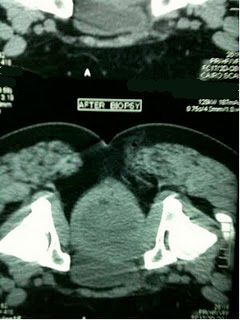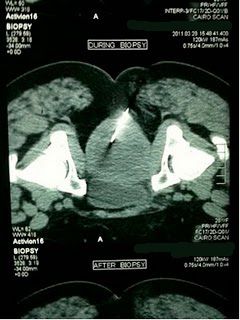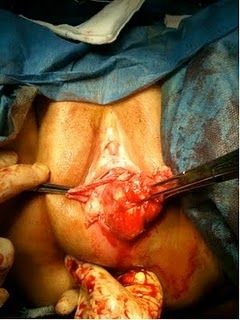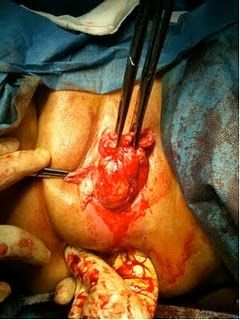Myofibroblastic Tumor of Rectovaginal Septum
Myofibroblastic tumor (MT) is a neoplasm of unknown etiology, occurring at various sites. Literary, it is composed of spindle cells (myofibroblasts). Usually it is associated with variable inflammatory component; hence the name is inflammatory myoblastic tumor (IMT). The occurrence in the rectovaginal septum of female is almost unknown in the literature.
Background
Myofibroblastic tumor (MT) is a neoplasm of unknown etiology, occurring at various sites. Literary, it is composed of spindle cells (myofibroblasts). Usually it is associated with variable inflammatory components; hence the name is inflammatory myoblastic tumor (IMT). The occurrence in the rectovaginal septum of female is almost unknown in the literature.
Abstract
An otherwise healthy 35 year old female, 6 months postpartum, presented with a vaginal mass and difficult intercourse. Gynecologic examination demonstrated a normal uterus with a posterior vaginal wall 10cm rounded mass. Excision and pathology proved the diagnosis of myofibrobalstic tumor.
Conclusion
Myofibroblastic tumors, although very rare should be considered in the differential diagnosis of masses in the posterior vaginal wall, rectovaginal septum or pouch of Douglas.
Continue to case presentation.
Case Presentation:
Myofibroblastic Tumor of Rectovaginal Septum
Background
Myofibroblastic tumor is usually associated with some inflammatory cells, hence named IMT and sometimes known as inflammatory pseudotumor tumor (IPT). It is a lesion of unknown etiology that has been reported in numerous anatomic sites. The tumor is composed of a dominant spindle cell proliferation with a variable inflammatory component. These spindle cells are now known to be myofibroblasts and this is the reason for the current designation for this disease. The inflammatory factor may not be applicable to all tumors, since some investigators have demonstrated the presence of chromosomal abnormalities and documented cases showing aggressive behavior supporting the theory that at least some of these tumors are true neoplasms. The tumor is more common in children with no predilection for sex, but in adult age it is more common in women who often present with fever of unknown origin or other vague, nonspecific symptoms. Splenomegaly is a frequent finding.
The tumor has been reported in the retropertoneum1-3, gastrointestinal tract, breast4, lung1, heart, urinary tract (bladder and kidney)5, uterus, pancreas6, mesentery and submandibular gland.
The outlook of this disease has changed with time from a benign reactive process to a malignant neoplasm, based on the multiple case reports demonstrating recurrent and constant clonal genetic alterations.7-10
IMT is an indolent spindle cell proliferation that can histologically resemble various malignant mesenchymal neoplasms; however, it generally behaves as a benign or locally recurrent tumor. Most IMTs involve the lung, mesentery, omentum, or retroperitoneum.
Case
MS is a 35 year old gravida 1, Para 1 who had spontaneous vaginal delivery 6 months earlier. She presented with a vaginal mass that was painless but causing difficult intercourse. She had been interviewed by a general surgeon who found 8-10 cm mass related to the posterior vaginal wall. He had performed a laparotomy, trying to reach the mass through the pouch of Douglas and when he failed, he tried to do a biopsy which was insufficient and inconclusive. Three weeks later she reported to our department, where examination showed an 8-10 cm sized mass between the rectum and posterior vaginal wall, slightly shifted to the right side of the midline. The mass was not cystic but firm, mobile and not tender and extending from 2 cm above the introitus, up to the level of posterior vaginal fornix. Rectal examination showed that the mass was in front of the rectum and upper part of the anal canal. A CT (Fig 1) and a directed biopsy (Fig 2), was carried out. It showed a 8-10 cm mass abutting the rectum but not infiltrating; the biopsy showed fibroid nature. Apart from that the patient gave no history of anything important and the examinations of all other systems were negative. She denied fever, her postpartum course had been uncomplicated and she was exclusively breast feeding since delivery. Laboratory data were unremarkable.
Fig 1 CT Image

Fig. 2 CT Directed Biopsy

She underwent vaginal route exploration for excision of the mass. The posterior vaginal wall was dissected off the mass upwards, the same way of doing rectocele repair. The mass had a false capsule, which helped in its dissection from the posterior vaginal wall. To dissect the mass from the rectum and the anal canal, the assistant inserted his finger in the anal canal trying to push the mass forward and anteriorly, to put it under tension and help in its dissection, and in the meanwhile alarming if dissection went close to the rectum to avoid its injury (Fig 3-4). Dissection continued and succeeded in taking the mass out. (Fig 5) It was extended from the introitus up to the pouch od Douglas. Closure was carried out, a drain was left that was removed after 24 hours and the postoperative period passed uneventful.
Fig 3-4 Dissection of the Tumor


Fig 5 Inflammatory Myoblastic Tumor

The patient had an uncomplicated recovery and was discharged home. The pathology report came back with a diagnosis of IMT, benign in nature.
Continue to case discussion.
Myofibroblastic Tumor of Rectovaginal Septum
Discussion
IMT is a relatively rare neoplasm. It was previously referred to as plasma cell granuloma, or inflammatory pseudo tumor (IPT). It has long been debated regarding the origin of IMT whether it was truly neoplastic or a post inflammatory process. The proposed etiologies included Epstein Barr virus (EBV), Human herpes virus (HHV8), and over expression of interleukin IL-6. Though other diseases like Kaposi's sarcoma and Castleman's diseases also have similar etiologies, molecular transcription form of open reading frame (ORF) -16, K13, 72 expressed in IMT are not expressed in the aforesaid diseases.11 Recently IMT is considered a neoplasm rather than a post-inflammatory process because of cytogenetic clonality, recurrent involvement of chromosomal region, occasional aggressive local behavior and metastasis of the tumor.1 With a differential diagnosis of a mass in the rectovaginal septum, one should always consider endometriosis nodule, tuberculosis or metastases, as it is mentioned an all the teaching text books. Of course that triad was considered, and was ruled out in our case by tumor markers, ultrasound, CT directed biopsy, and the past medical history. The mobility of the mass and rectal examination almost excluded a malignant cause of either rectal or metastatic origin. Endometriosis should have been diagnosed by the associated clinical picture of endometriosis in addition to rectal complaints like tenenesums and maybe constipation.
Excision was the definitive treatment; however, the route of the excision was a matter of debate. The general surgeon when asked preferred the abdominal exploration but since gynecologists know that anatomical area more than any other specialty physician, the vaginal route was opted.
Conclusion
IMT is a rare neoplasm of uncertain biological potential. Complete surgical resection remains the mainstay of the treatment. IMT although rare, should be considered as a diagnosis.
References:
References
1. Coffin CM, Watterson J, Priest JR, Dehner LP: Extrapulmonary inflammatory myofibroblastic tumor (inflammatory pseudotumor). A clinic pathologic and immuno-histochemical study of 84 cases. Am J Surg Pathol 1995, 19:859-872.
2. Esmer-Sanchez D, Rangel D: Inflammatory pseudotumor of the retroperitoneum. Rev Gastroenterol Mex 2002, 67:97-99.
3. Tambo M, Kondo H, Kitauchi T, Hirayama A, Cho M, Fujimoto K, Yoshida K, Ozono S, Hirao Y, Yamada E, Ichijima K: A case of inflammatory myofibroblastic tumor of the retroperitoneum. Hinyokika Kiyo 2003, 49:273-27
4. Sastre-Garau X, Couturier J, Derre J, Aurias A, Klijanienko J, Lagace R: Inflammatory myofibroblastic tumour (inflammatory pseudotumour) of the breast. Clinicopathological and genetic analysis of a case with evidence for clonality.J Pathol 2002, 196:97-102.
5. Kapusta LR, Weiss MA, Ramsay J, Lopez-Beltran A, Srigley JR: Inflammatory myofibroblastic tumors of the kidney: a clinicopathologic and immunohistochemical study of 12 cases.Am J Surg Pathol 2003, 27:658-666.
6. Pungpapong S, Geiger XJ, Raimondo M: Inflammatory myofibroblastic tumor presenting as a pancreatic mass: a case report and review of the literature. JOP 2004, 5:360-367.
7. Coffin CM, Dehner LP, Meis-Kindblom JM: Inflammatory myofibroblastic tumor, inflammatory fibrosarcoma, and related lesions: an historical review with differential diagnostic considerations. Semin Diagn Pathol 1998, 15:102-110.
8. Freeman A, Geddes N, Munson P, Joseph J, Ramani P, Sandison A, Fisher C, Parkinson MC: Anaplastic lymphoma kinase (ALK 1) staining and molecular analysis in inflammatory myofibroblastic tumors of the bladder: a preliminary clinicopathological study of nine cases and review of the literature. Mod Pathol 2004, 17:765-771.
9. Biselli R, Boldrini R, Ferlini C, Boglino C, Inserra A, Bosman C: Myofibroblastic tumors: neoplasias with divergent behavior. Ultrastructural and flow cytometric analysis. Pathol Res Pract 1999, 195:619-632.
10. Mentzel T, Dry S, Katenkamp D, Fletcher CD. Low-grade myofibroblastic sarcoma: analysis of 18 cases in the spectrum of myofibroblastic tumors. Am J Surg Pathol. 1998;22:1228â1238.
11. Gomez-Roman JJ, Sanchez-Velasco P, Ocejo-Vinyals G, Hernandez-Nieto E, Leyva-Cobian F, Val-Bernal JF: Human herpesvirus-8 genes are expressed in pulmonary inflammatory myofibroblastic tumor (inflammatory pseudotumor).Am J Surg Pathol 2001, 25:624-629.
